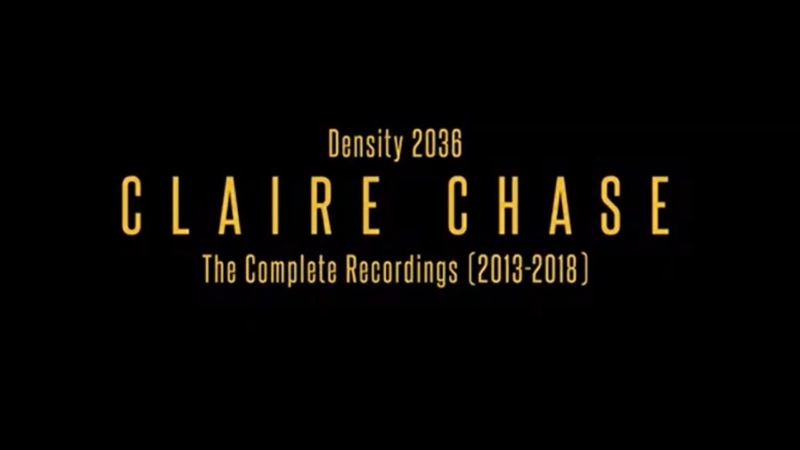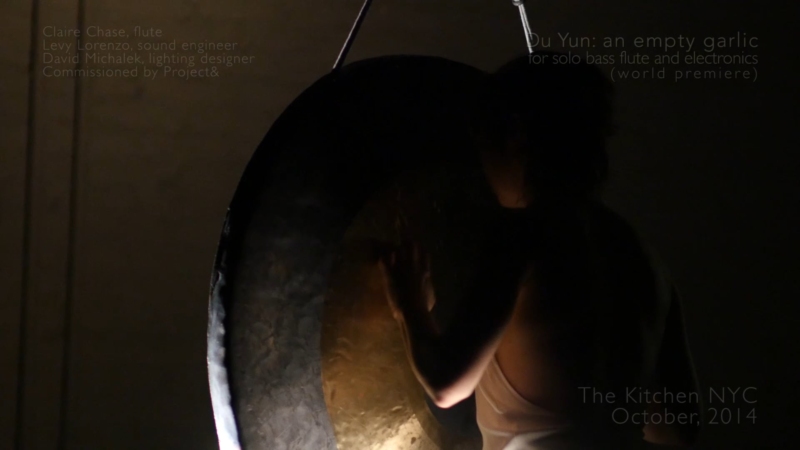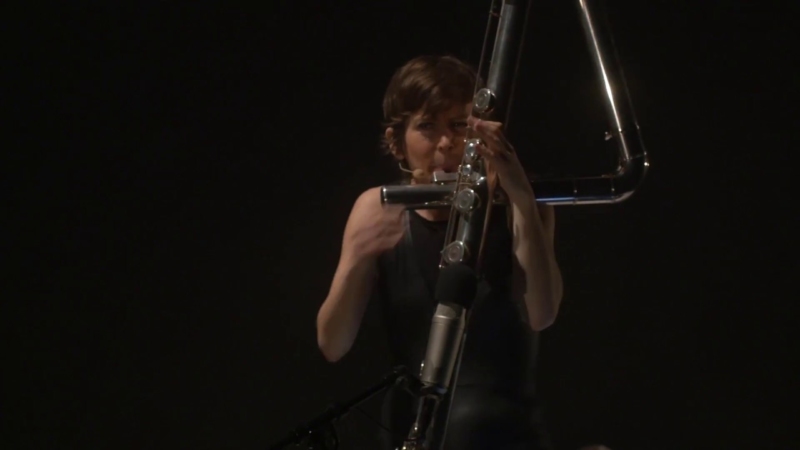READER: TOGETHER
17.08.2023
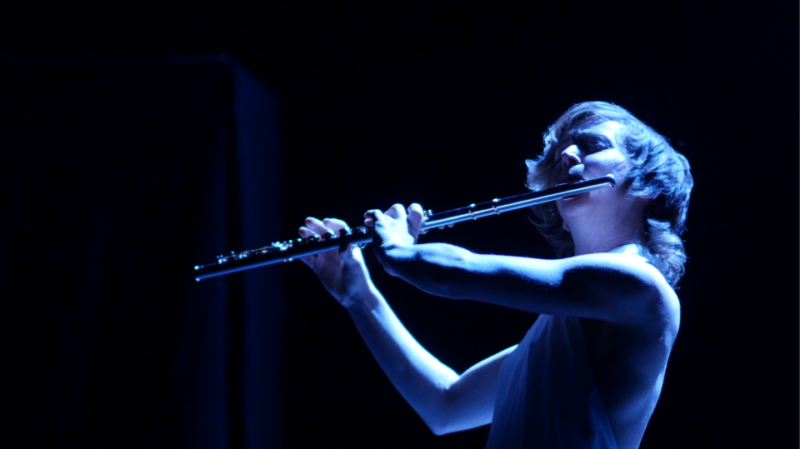
Olga Neuwirth: “Magic Flu-idity” (2019) – 14’
for flute and typewriter
Anna Thorvaldsdottir: “Ubique” (2023) – 6’
for flute, piano, two cellos and electronics (excerpt)
Matana Roberts: “Auricular Hearsay” (2021) – 10’
for open ensemble
Du Yun: “An Empty Garlic” (2014) – 13’
for bass flute and electronics
Tyshawn Sorey: “Bertha’s Lair” (2016, rev. 2020) – 10’
for flute and percussion
Claire Chase (Flutes)
David Auli Morales (Typewriter)
Han geul Lee (Piano)
Cassandra Hutsteiner (Violoncello)
Sebastian Triebener (Violoncello)
Jorge Sánchez-Chiong (Electronics)
Katherine Young (Bassoon)
Kalun Leung (Trombone)
Matthew LeVeque (Percussion
Tyshawn Sorey (Percussion)
Aaron Holloway-Nahum (Sound Direction)
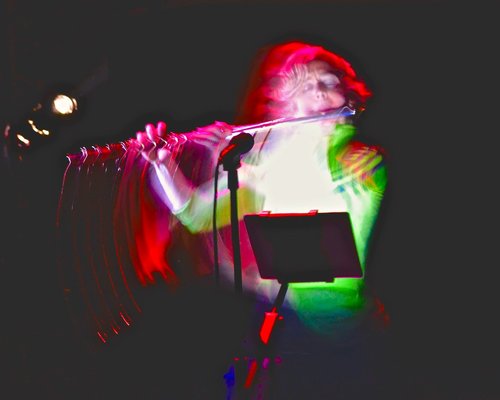
Claire ChaseFor Darmstadt this summer, I thought it would be interesting to remount a selection of the collaborative “Density” pieces with participants of the Darmstadt Summer Course. It’s been wonderful to relearn and reimagine this material with a younger generation of players.
CLAIRE CHASE ON “DENSITY 2036”
Gerardo Scheige: You presented some of the compositions of “Density 2036” during the Darmstadt Summer Course 2021. The general project text on the website speaks of a “new program of flute music that seeks to expand the boundaries of the instrument”. Which are these boundaries? Did any changes appear during the last two years?
Claire Chase: The boundaries are constantly changing! As the author Donna Haraway has said, when you venture beyond what you know, “the wild multiplies”. So, the project is really an invitation – to composers, sound artists, performers, improvisers and listeners – to go beyond what we think we know about the flute, humankind’s oldest musical instrument, and to step into a kind of transhistorical space of wild possibility. That’s what excites me most.
GS: How did the program of this year’s Darmstadt Summer Course concert turn out? How did you choose the composers?
CC: The initial intent of the “Density 2036” project was to create a new body of solo repertory for the flute, but the truth is that I got bored with that endeavor quite quickly, and by the fourth installation of the project in 2016 I really wanted to work collaboratively again. The duo that Tyshawn and I made that year was a turning point, and many more collaborative iterations of “Density” followed: a duo with flute and Ondes Martenot, multiple works for flutes and voices, an opera for flute with an intergenerational community ensemble, as well as others that spun out from there. Even the evening-length “solo” contrabass flute work that Liza Lim wrote for me in 2020 is intensely collaborative at its core, both with the live-electronics performer and with the kinetic percussion that I play in the piece, which has its own subjectivity and aliveness. The forthcoming 2024 “Density” is a collaboration with Terry Riley which will be entirely open in instrumentation and duration, and I am planning dozens of different small and large ensemble realizations of it.
For Darmstadt this summer, I thought it would be interesting to remount a selection of these collaborative “Density” pieces with participants of the Darmstadt Summer Course. It’s been wonderful to relearn and reimagine this material with a younger generation of players. There is only one solo piece on the concert, Du Yun’s An Empty Garlic from 2014, and this was a special request from Thomas Schäfer. Even that piece doesn’t feel lonely when I play it; Du Yun is always with me in my mind, singing along.
GS: What’s special/unique about it? And what challenges does it present?
CC: Each of these pieces is distinct in its aesthetic, its approach to the instrument and its notational language. The challenge – or the invitation, as I like to think of it – is to be increasingly multilingual as a performer and to move swiftly between precisely notated and improvised modes over the course of the program, exploring the vibrant continuum in between what’s archived on the page and what happens only once, never to happen again. For me this has been a particularly rich process to go through with students these past weeks as we have been surrounded by elders like Anthony Braxton and George Lewis, whose groundbreaking contributions as both performers and composers have shaped my generation’s understanding of what might be possible for future musics. I’m incredibly grateful to them, and to the fabulous folks who have joined me in the process of reimagining these pieces over the last two weeks: tutors Tyshawn Sorey, Jorge Sánchez-Chiong and Katherine Young; and students David Auli Morales, Sebastian Triebener, Han geul Lee, Cassandra Hutsteiner, Matthew LeVeque and Kalun Leung. The future is bright!
MAGIC FLU-IDITY
Olga Neuwirth’s “Magic Flu-idity” is a reduction of her recent flute concerto “Aello – ballet mécanomorphe” which she wrote for Claire Chase and the Swedish Chamber Orchestra in 2018 as a companion piece to Bach’s “Brandenburg Concerto No. 4″. In the flute concerto version, scored for solo flute, two muted trumpets, string ensemble, keyboard and typewriter, “Aello” alludes to one the harpies of classical mythology, “someone sent by the gods to restore peace, if necessary with force, and to exact punishment for crimes”” Mark Berry of “Seen And Heard International” described it this way: “In three movements, like its companion, it immediately spoke with the tones – in every sense – of a serious composer at work. Figures remembered from Bach, whether melodic, rhythmic, or both, sounded as if trapped in a machine. Or were they actually perfectly happy to be there? Claire Chase on flute, shadowed by two muted trumpets, offered breathtaking virtuosity, set against an ever-changing ensemble that included synthesized harpsichord and glass harmonica as well as portable typewriter. Machines can be fun as well as serious – indeed sometimes especially when they are serious. So too can Bach.”
In this new duo version, both the solo flute and the typewriter absorb lines of the original concerto, conjuring the spirit of “Aello” – at times capricious, at others demonic – with orchestral force.
Website Density 2036
UBIQUE
“Ubique” lives on the border between enigmatic lyricism and atmospheric distortion. Through a combination of sounds, pitches and textural nuances, low deep drones envelop lyrical materials and harmonies that breathe in and out of focus throughout the progress of the piece. The flow of the music is primarily guided by continuous expansion and contraction — of various kinds and durations — as it streams with subtle interruptions and frictions but ever moving forward in the overall structure.
The work is inspired by the notion of being everywhere at the same time, an enveloping omnipresence, while simultaneously focusing on details within the density of each particle, echoed in various forms of fragmentation and interruption and in the sustain of certain elements of a sound beyond their natural resonance – throughout the piece, sounds are both reduced to their smallest particles and their atmospheric presence expanded towards the infinite.
As with my music generally, the inspiration is not something I am trying to describe through the music as such – it is a way to intuitively approach and work with the core energy, structure, atmosphere and material of the piece.
“Ubique” is 50 minutes in duration and is written in 11 parts, for flutes, grand piano, 2 cellos and pre-constructed electronics. The piece was commissioned by the Pnea Foundation, with lead funds from the Cheswatyr Foundation and Carnegie Hall for Claire Chase’s “Density” project.
With love, for Claire, Cory, Katinka, Seth and Levy.
Anna Thorvaldsdottir
Warning: Undefined array key "" in /www/htdocs/w00b9098/relaunch-2018/content/themes/imd/lib/rah/ThemeBase/VideoEmbed.php on line 117
Warning: Trying to access array offset on value of type null in /www/htdocs/w00b9098/relaunch-2018/content/themes/imd/lib/rah/ThemeBase/VideoEmbed.php on line 117
AURICULAR HEARSAY
“Auricular Hearsay” is a conceptual sound work that uses a mixed media framework Roberts is currently developing called “Endless Score”. The work is a visual and sonic exploration of the brains of the neurodiverse. Neurodiverse brains operate in starts, stops, spurts. They never rely on a linear track, often flowing in the moment, taking risk, using improvisation as a root for inquiry and organization of various realms of logic. “Endless Score” is at its foundation a sonic experiment in real time, a tool for infinite performative iteration of a set of guided sounds/instruction, not unlike the models of music restatement, theme and variation that exist within many types of music traditions worldwide, the difference here being the use of a key foundational physiological phenomena to anchor all that will be explored by composer, performer and listener in real time.
Website Density 2036
AN EMPTY GARLIC
In memoriam for a beloved friend, “An Empty Garlic” draws on the sarabande, a baroque dance form, and more specifically one well known from Bach’s “Partita in A minor” for solo flute. At the same time, it was inspired by one of Rumi’s mystical poems. “I often wonder about bereavement,” Du Yun writes in the program notes for the 2014 premiere. “When and how it pauses, recharges, morphs and restarts… I am so close to you I am distant, I am so mingled with you I am apart, I am so open I am hidden, I am so strong I totter.”
Website Density 2036
BERTHA’S LAIR
A colorful instrument of myriad possibilities and beauty, the flute is an instrument that has been central to much of the work that I produced during recent years. It has been a tremendous honor for me to have collaborated with some of the most brilliantly virtuosic practitioners on that instrument, from Margaret Lancaster, Alice Teyssier, and Malik Mezzadri to Laura Cocks, Nicole Mitchell and Claire Chase – all individuals who continue to stretch beyond the limits of that instrument in their own, personal way. I am indebted to all of these masters for their inspiration and courage to further my writing for the flute.
Which brings us to “Bertha’s Lair”, an explosive tour-de-force written exclusively for Chase and myself (on drum set or unpitched percussion) that further exemplifies my penchant in exploring the improvisation-composition continuum, as evidenced in my “Trio for Harold Budd” (2012) and “Ornations” (2014). One of the rarer members of the woodwind family, the instrument lovingly known as Bertha (after whom this work is named) is anything but simply a contrabass flute; ostensibly there exists a seemingly vast amount of readily available sonic possibilities to explore. However, I also found it necessary to create a work for this instrument that is full of high, raucous energy – to write music that is counterintuitive to using certain “effects” that are more customary for the instrument (that is, to avoid as much as possible the use of long, quiet, mysterious sounds, whistle tones, etc.) – and focus more on shape, line, color, texture, ritual and most of all, the physicality of live performance on this particular instrument. This avoidance principle is strictly adhered to until the very last system of the composition.
This work is dedicated to the late Pauline Oliveros (1932–2016), who was the first to compose a piece for Bertha to be performed by Chase, and who named the instrument at first hearing.
Tyshawn Sorey
The version played in today’s concert is for flute and percussion.

